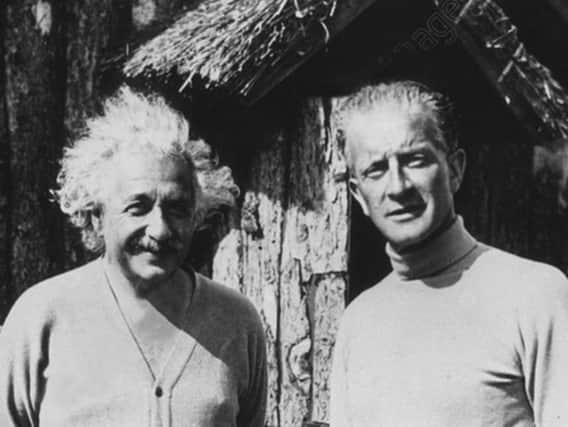A family's links to Nelson, Rasputin and King Farouk


Sir Curtis died in 1885 on his Sussex estate at Rowfant, near Crawley Down.
Lampson was succeeded as a hereditary knight by eldest son, George. The youngest son, Norman, was the father of prominent diplomat Miles Wedderburn Lampson who served at various times in Japan, China, Egypt and the Sudan.
Advertisement
Hide AdAdvertisement
Hide AdMiles Lampson was in Egypt in the Second World War at a time when British and Commonwealth forces of the Eighth Army were desperately battling Rommel and his Afrika Corps to prevent them seizing control of the strategically vital Suez Canal. Egypt itself was ostensibly neutral though very much under British rule. In 1942 ambassador Lampson requested that King Farouk make changes to his government to make it more compliant to British interests. Farouk prevaricated and on the night of 4th February, Allied troops and tanks surrounded the royal palace in Cairo. In a blatant exercise of “gunboat diplomacy”, Lampson presented King Farouk with an ultimatum; bow to the British wishes or lose the throne. Farouk gave in.
Let’s turn now to Sir Curtis Lampson’s only daughter, Hannah Jane, and her husband, Edward Hawke Locker, who provide us with another fascinating story. The latter was born in Greenwich Hospital in 1821. Locker’s grandfather had been in the Royal Navy commanding “HMS Lowestoffe”. On a 1777 voyage to the West Indies his crew included a very young Horatio Nelson and Locker’s influence on him was immense. In 1799, the now Admiral Nelson wrote to his former captain: “I have been your scholar … it is you who always told me ‘lay a Frenchman close and you will beat him’. Our friendship will never end but with my life.”
Edward Locker was poor in health but he matured into a distinguished man of letters and poetry. His first marriage in 1850 was to Lady Charlotte Bruce, daughter of Lord Elgar, the man who famously brought the marbles to England from Athens. In 1857 Locker published “London Lyrics”, his first book of poetry.
The couple had a single child, Eleanor, but in 1872 Lady Charlotte died. Eleanor later married Lionel Tennyson, a son of Alfred Lord Tennyson. You may recall that the poet laureate was a good friend of Sir Curtis Lampson and it’s likely that through this connection Edward Locker met Hannah Jane. In 1874 they married and took on the family surname of Locker-Lampson. The double-barreled appellation was the wish of Sir Curtis and it enabled the couple to live at Rowfant where they produced four children.
Advertisement
Hide AdAdvertisement
Hide AdThough but a minor star in the panoply of Victorian literary figures, Edward Locker-Lampson was well acquainted with all the big names of the age including Charles Dickens, the Brownings, Thackery and Trollope. He was well regarded as a convivial host and raconteur. I very much like his observation: “The world is as ugly as sin. And almost as delightful.”
In 1886 he produced “The Rowfant Library”, a catalogue of his much-lauded collection of rare books. In 1892 the work inspired the founding of the Rowfant Club in Cleveland, USA, for people “interested in the critical study of books to please the mind of man”. It is still going today.
Edward Locker-Lampson died at Rowfant in 1895. His youngest son led an extraordinary life and ended up as Commander Oliver Stillingfleet Locker-Lampson CMG, DSO. He was a journalist but in 1910, aged 30, became a Conservative MP. His trenchant right-wing views included opposition to Irish Home Rule.
In December 1914 Locker-Lampson joined the Royal Navy Volunteer Reserve as a Lieutenant Commander, a post vouched for by Winston Churchill, then First Lord of the Admiralty. Churchill asked him to establish an armoured car unit for the Royal Naval Air Service. Following training, Locker-Lampson's No. 15 Squadron went to France but stalemate in the trenches negated the unit’s potential for mobile warfare.
Advertisement
Hide AdAdvertisement
Hide AdIn 1916 in a show of support for Russian Tsar Nicholas II and his hard-pressed army, Locker-Lampson sailed with his squadron of armoured cars to the arctic port of Murmansk. From there his vehicles ranged as far south as the Caucasus Mountains skirmishing with the invading Germans.
Commander Locker-Lampson never denied talk of involvement in machinations in the Russian court and even of being implicated in the murder of the “mad monk” Rasputin who wielded a malign influence over the Tsarina. He also proposed a plan to spirit the royal family out of Russia following the Tsar’s abdication in March 1917.
Post-war, Locker-Lampson warned of communist meddling in Britain’s home affairs. In 1931 he formed the Blue Shirts movement with the intention to “peacefully fight Bolshevism and clear out the Reds”. Their motto was his own family motto: “Fear God! Fear Naught!” In 1932 the Nazi Alfred Rosenberg visited Britain and was introduced to Locker-Lampson who was truly shocked to learn that Hitler believed the Blue Shirts to be fellow fascists.
From that time onwards, the MP determined on a personal crusade against totalitarianism. In the summer of 1933 he gave refuge to the physicist Albert Einstein who had received death threats while living in Belgium. Locker-Lampson took Einstein to meet Winston Churchill. Later he assisted Ethiopia’s Emperor Haile Selassie find sanctuary in Sussex and evade the clutches of Mussolini. He also helped scores of ordinary Jewish families fleeing Nazi Germany.
Advertisement
Hide AdAdvertisement
Hide AdIn the Second World War he joined the Home Guard and gave his full parliamentary support to Prime Minister Churchill. He retired from politics at the 1945 General Election and died in 1954.
Commander Locker-Lampson is buried along with his father and other family members in Worth churchyard.